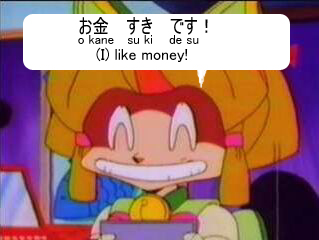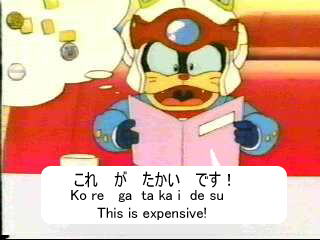Lesson 11: "Numbers and Money"
 Counting is usually one of the first things people learn when studying another language, because it's usually one of the easier things to learn. Japanese is a bit more complex when it come to counting though. Japanese has different ways for counting different things. In English, you can say "Three people", "Three years old" and "Three minutes", as long as you know "Three", you can count three of these things. In Japanese, it would be "San-nin" (3 people), "Mittsu" (3 years old), and "Sam-pun" (3 minutes). So, you see there is a bit more to it than just learning "san" (the number 3). But, don't panic, you can do this. It might take a bit longer than learning to count in some other languages, but you'll see there is a system to it that will help you learn. But, to start with, you need to learn the numbers first.
Counting is usually one of the first things people learn when studying another language, because it's usually one of the easier things to learn. Japanese is a bit more complex when it come to counting though. Japanese has different ways for counting different things. In English, you can say "Three people", "Three years old" and "Three minutes", as long as you know "Three", you can count three of these things. In Japanese, it would be "San-nin" (3 people), "Mittsu" (3 years old), and "Sam-pun" (3 minutes). So, you see there is a bit more to it than just learning "san" (the number 3). But, don't panic, you can do this. It might take a bit longer than learning to count in some other languages, but you'll see there is a system to it that will help you learn. But, to start with, you need to learn the numbers first.
0 = rei (rey) Also, the English "zero" (zeh-roh) is commonly used in Japanese.
1 = ichi (ee-chee)
2 = ni (nee)
3 = san (sahn)
4 = yon (yohn) Also, shi = (shee)
5 = go (goh)
6 = roku (roh-ku)
7 = nana (nah-nah) Also, shichi (shee-chee)
8 = hachi (ha-chee)
9 = kyu (kyu)
10 = ju (ju)
After you get to ten, you just add another number to get the "teen" numbers, like "Ju-ichi" (11), Ju-ni (12), Ju-san (13). Easy, ne? Now, moving on from there:
20 = ni-ju (nee-ju)
Notice that it is just the number 2 put before the number 10, like saying "two tens". If you want to say "25", you just add "go" (5) to get ni-ju-go (25). Learn the numbers 1 through 10 in Japanese, and you can count all the way to 99 (kyu-ju-kyu) like this.
100 = hyaku (huyah-ku)
200 = ni-hyaku (nee-huya-ku)
But now things start to change a bit...
300 = san-byaku (sahn-buya-ku)
I don't know why "hyaku is suddenly changed to "byaku" for this, but it is. Then it's back to "hyaku" again for 400:
400 = yon-hyaku (yohn-huya-ku)
500 = go-hyaku (goh-huya-ku)
Then another twist for 600:
600 = roku-hyaku (roh-ku-huya-ku)
OR
rop-pyaku (Rohp'puya-ku)
Obviously, "roku-hyaku" is easier for you to learn, since you just need to remember the Japanese numbers 6 and 100, but if you hear someone say "rop-pyaku", you should know what it means.
700 = nana-hyaku (nah-nah-huya-ku)
Then another odd one:
800 = hap-pyaku (hap'puya-ku)
Like with "roku-hyaku", you can also use the more logical combination of the Japanese 8 and 100 for "Hachi-hyaku". But you should still learn "Hap-pyaku" too.
Finally:
900 = kyu-hyaku (kyu-huya-ku)
Now onto 1000. You might not think you really need to count so high very often, but if you ever go to Japan, you'll find that prices for things are often in thousands of yen. Japanese currency comes in 1,000, 5,000, and 10,000 yen notes.
1,000 = sen (sehn)
Like with 10's and 100's, adding a number before "sen" will show how many 1,000's, and the numbers after "sen" will show the amount of 100's, 10's and ones added to the 1,000. So, "ni-sen-go-hyaku-san-ju-roku" would be "two thousand, five hundred, thirty six"
Like with the 100's, there's one odd ball in the 1,000's; 3,000 is "san-zen". But other than that, they are all the Japanese number plus "sen". This will get you up to 9,000. For 10,000, "sen" is replaced by "man" (mahn):
10,000 = ichi-man (ee-chee-mahn)
From there, using the numbers you already know before and after "man", you can count all the way to "Hyaku-man" (a million). Notice that "man" is not used by itself, but with "ichi" added. You can use "Hyaku" and "Sen" by themselves, just like you can say "a hundred" and "a thousand" in English instead of "one hundred" and "one thousand".
 I mentioned that Japanese has different ways for counting different things, the basic numbers we learned in this lesson can be used for counting money. So, before we finish up this lesson, let's learn a few words that can help you deal with money. Okane (oh-ka-neh) is the word for money in general. Ikura (ee-ku-rah) is "amount", so to ask a price on something, you can ask "Ikura des' ka?" which is like "How much is it?". It might be Takai (tah-kaee), "expensive", or Yasui (yah-su-ee), "cheap". Then you can pay with your paper currency, Satsu (saht-su), and coins, Dama (dah-mah). Modern Japanese money is called "yen" in English, but in Japanese it's really just "en". In old Edo era Japan, (and in Kyatto Ninden Teyande), the unit of money was the Ryou (ruyoh)
I mentioned that Japanese has different ways for counting different things, the basic numbers we learned in this lesson can be used for counting money. So, before we finish up this lesson, let's learn a few words that can help you deal with money. Okane (oh-ka-neh) is the word for money in general. Ikura (ee-ku-rah) is "amount", so to ask a price on something, you can ask "Ikura des' ka?" which is like "How much is it?". It might be Takai (tah-kaee), "expensive", or Yasui (yah-su-ee), "cheap". Then you can pay with your paper currency, Satsu (saht-su), and coins, Dama (dah-mah). Modern Japanese money is called "yen" in English, but in Japanese it's really just "en". In old Edo era Japan, (and in Kyatto Ninden Teyande), the unit of money was the Ryou (ruyoh)
Kore wa, ikura des' ka? = This, amount is? (How much is this?)
San-zen-go-hyaku en des'. = It is three thousand, five hundred yen.
Sen en satsu = A 1,000 yen note
Go-hyaku en dama = A 500 yen coin
Ichi ryou dama = A 1 ryou coin
Now, don't rush off to Japan to spend your yen yet. Study these for now, and next time we'll learn how to say how many of these different items you want.
 I mentioned that Japanese has different ways for counting different things, the basic numbers we learned in this lesson can be used for counting money. So, before we finish up this lesson, let's learn a few words that can help you deal with money. Okane (oh-ka-neh) is the word for money in general. Ikura (ee-ku-rah) is "amount", so to ask a price on something, you can ask "Ikura des' ka?" which is like "How much is it?". It might be Takai (tah-kaee), "expensive", or Yasui (yah-su-ee), "cheap". Then you can pay with your paper currency, Satsu (saht-su), and coins, Dama (dah-mah). Modern Japanese money is called "yen" in English, but in Japanese it's really just "en". In old Edo era Japan, (and in Kyatto Ninden Teyande), the unit of money was the Ryou (ruyoh)
I mentioned that Japanese has different ways for counting different things, the basic numbers we learned in this lesson can be used for counting money. So, before we finish up this lesson, let's learn a few words that can help you deal with money. Okane (oh-ka-neh) is the word for money in general. Ikura (ee-ku-rah) is "amount", so to ask a price on something, you can ask "Ikura des' ka?" which is like "How much is it?". It might be Takai (tah-kaee), "expensive", or Yasui (yah-su-ee), "cheap". Then you can pay with your paper currency, Satsu (saht-su), and coins, Dama (dah-mah). Modern Japanese money is called "yen" in English, but in Japanese it's really just "en". In old Edo era Japan, (and in Kyatto Ninden Teyande), the unit of money was the Ryou (ruyoh) Counting is usually one of the first things people learn when studying another language, because it's usually one of the easier things to learn. Japanese is a bit more complex when it come to counting though. Japanese has different ways for counting different things. In English, you can say "Three people", "Three years old" and "Three minutes", as long as you know "Three", you can count three of these things. In Japanese, it would be "San-nin" (3 people), "Mittsu" (3 years old), and "Sam-pun" (3 minutes). So, you see there is a bit more to it than just learning "san" (the number 3). But, don't panic, you can do this. It might take a bit longer than learning to count in some other languages, but you'll see there is a system to it that will help you learn. But, to start with, you need to learn the numbers first.
Counting is usually one of the first things people learn when studying another language, because it's usually one of the easier things to learn. Japanese is a bit more complex when it come to counting though. Japanese has different ways for counting different things. In English, you can say "Three people", "Three years old" and "Three minutes", as long as you know "Three", you can count three of these things. In Japanese, it would be "San-nin" (3 people), "Mittsu" (3 years old), and "Sam-pun" (3 minutes). So, you see there is a bit more to it than just learning "san" (the number 3). But, don't panic, you can do this. It might take a bit longer than learning to count in some other languages, but you'll see there is a system to it that will help you learn. But, to start with, you need to learn the numbers first.